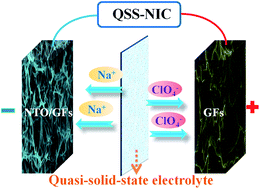Self-supported electrodes of Na2Ti3O7 nanoribbon array/graphene foam and graphene foam for quasi-solid-state Na-ion capacitors†
Abstract
There is an urgent need but it is still a huge challenge to integrate high energy and power density with high safety in a single energy storage device. Addressing this issue largely depends on design of new energy storage systems with novel electrode architectures. Herein, a novel electrochemical energy storage device called a quasi-solid-state Na-ion capacitor (QSS-NIC) is designed based on a 3D self-supported Na2Ti3O7 nanoribbon array/graphene foam (NTO/GF) anode and graphene foam (GF) cathode, and a Na-ion conducting gel polymer as the electrolyte and separator, without any binders, conducting additives or metal current collectors. Benefiting from the unique 3D self-supported cathode and anode, the GF//NTO/GF configuration achieves a high energy density of 70.6 W h kg−1 and high power density of 4000 W kg−1 on the basis of the mass of both electrodes, and a prominent cycling stability over 5000 cycles (capacitance retention ∼73.2%). This work successfully demonstrates a proof of concept of QSS-NIC as a high performance energy storage device based on two self-supported electrodes, which could provide a feasible approach to bridge the performance gap between capacitors and Na-ion batteries.



 Please wait while we load your content...
Please wait while we load your content...